List of prehistoric insects
Prehistoric insects are various groups of insects that lived before recorded history. Their study is the field of paleoentomology. Insects inhabited Earth since before the time of the dinosaurs. The earliest identifiable insect is the Devonian Rhyniognatha hirsti, estimated at 407 to 396 million years ago. Forms similar to many modern insects had already evolved before the dawning of the dinosaur and lived alongside them and beyond up to the present day. Like today, prehistoric insects were an important part of the food chain in their time.
The differences between modern and prehistoric varieties can be essential, and, like many other creatures of prehistory, the latter tended to be much larger than their contemporary equivalents. This size difference is thought to be due to higher atmospheric oxygen levels (allowing diffusion through spiracles over greater distances), higher temperatures (enhancing metabolism), and the absence of birds as key predators of insect life.[1]
Since insects have chitin exoskeletons rather than mineralized bones, their burial processes differ compared to the fossils of much larger vertebrates such as dinosaurs. Many insect remains are found preserved in the hardened sap of ancient trees (amber).
Incomplete list of prehistoric insects arranged by extinction date:
Devonian
| Name | Authors | Unit | Location | Notes | Images |
|---|---|---|---|---|---|
|
Tillyard, 1928 |
oldest described insect |
Carboniferous
| Name | Authors | Unit | Location | Notes | Images |
|---|---|---|---|---|---|
|
Brongniart, 1885 |
three described species |
||||
|
Prokop & Nel, 2010 |
Kladno Formation |
||||
|
Ren, Nel & Prokop, 2008 |
Tupo Formation |
A griffenfly |
Permian
Jurassic
| Name | Authors | Unit | Location | Notes | Images |
|---|---|---|---|---|---|
|
Li, Ren & Shih, 2008 |
A hangingfly |
||||
|
Li, Ren & Shih, 2008 |
A hangingfly |
||||
|
Petrulevicius, Huang & Ren, 2007 |
A hangingfly |
||||
|
Engel & Ren, 2008 |
A snakefly |
Cretaceous
| Name | Authors | Unit | Location | Notes | Images |
|---|---|---|---|---|---|
|
Dlussky, Brothers & Rasnitsyn, 2004 |
A myrmicin ant |
||||
|
Dlussky, Brothers & Rasnitsyn, 2004 |
A ponerin ant, 2 species |
||||
|
Pérez-de la Fuente, et al, 2012 |
Spanish amber |
A snakefly |
| ||
|
Pérez-de la Fuente, et al, 2012 |
Spanish amber |
A snakefly |
| ||
|
Dlussky, 1983 |
Asia and Africa |
A family of "ant like wasps" |
|||
|
Engel, 2011 |
An earwig |
| |||
|
Dlussky, 1996 |
A possible aneuretin ant, one species |
| |||
|
Pérez-de la Fuente, et al, 2010 |
Spanish amber |
A snakefly |
| ||
|
Olmi, Rasnitsyn & Guglielmino, 2010 |
Khurilt rock unit |
An earwig |
| ||
|
Chatzimanolis et al, 2010 |
A rove beetle |
||||
|
Dlussky, 1996 |
A sphecomyrmin ant, three species |
| |||
|
Perrichot et al, 2008 |
Charentese amber |
A sphecomyrmin ant |
| ||
|
McKellar, Glasier, & Engel, 2013 |
Canadian amber |
A sphecomyrmin ant |
| ||
|
Jepson, Ansorge & Jarzembowski, 2011 |
A snakefly |
||||
|
Chatzimanolis et al, 2010 |
A rove beetle |
||||
|
Bechly & Wolf-Schwenninger, 2011 |
Lebanese amber |
A snakefly |
|||
|
Oman, 1937 |
A leafhopper |
||||
|
Engel, 2002 |
A snakefly |
||||
|
Pérez-de la Fuente, et al, 2010 |
Spanish amber |
A snakefly |
| ||
|
Brothers, 2011 |
A wasp of the extinct family Plumalexiidae |
| |||
|
Makarkin & Menon, 2007 |
An Ithonidae lacewing. |
||||
|
Martynova, 1941 |
Europe & Asia |
A Jurassic - Cretaceous snakefly genus; three species |
|||
|
Engel & Ren, 2008 |
Europe & Asia |
A Jurassic - Cretaceous snakefly genus; two species |
| ||
|
Engel & Grimaldi, 2014 |
An earwig |
||||
|
Engel, 2011 |
An earwig |
| |||
|
Peng, Makarkin, Wang, & Ren, 2011 |
A silky lacewing |
| |||
|
Barden & Grimaldi, 2013 |
A sphecomyrmin ant |
| |||
|
Engel & Grimaldi, 2014 |
An earwig |
||||
Eocene
| Name | Authors | Unit | Location | Notes | Images | |
|---|---|---|---|---|---|---|
|
Wheeler, 1910 |
| |||||
|
Engel, 2011 |
||||||
|
Makarkin & Archibald, 2014 |
A possible psychopsid lacewing |
| ||||
|
Makarkin & Archibald, 2009 |
An Ithonidae moth lacewing |
| ||||
|
(Mayr, 1868) |
A dolichoderin ant |
| ||||
|
(Mayr, 1868) |
A dolichoderin ant |
| ||||
|
(Wheeler, 1915) |
A dolichoderin ant |
| ||||
|
Cockerell, 1906 |
||||||
|
Cockerell, 1906 |
||||||
|
Carpenter, 1930 |
||||||
|
Carpenter, 1930 |
| |||||
|
Wheeler, 1915 |
| |||||
|
Wheeler, 1915 |
| |||||
|
Mayr, 1868 |
| |||||
|
Handlirsch, 1910 |
Horsefly beds |
| ||||
|
Cockerell, 1923 |
Green River Formation, Messel Pit, |
A myrmeciine ant genus, four species described |
| |||
|
Carpenter, 1930 |
||||||
|
Yunakov & Kirejtshuk, 2011 |
A broad nosed weevil |
| ||||
|
Wheeler, 1915 |
A dolichoderine ant. |
| ||||
|
Archibald, Cover, & Moreau, 2006 |
A bulldog ant genus; three species known |
|||||
|
Skalski, 1995 |
A metallic moth, two species |
| ||||
|
Gibson, 2009 |
| |||||
|
Evenhuis, 2002 |
A Mythicomyiidae fly |
|||||
|
(Ponomarenko, 1975) |
A dryinid wasp |
| ||||
|
Guglielmino & Olmi, 2011 |
A dryinid wasp |
| ||||
|
Chaboo & Engel, 2009 |
A tortoise beetle |
|||||
|
Archibald, 2005 |
Canada and the United States |
A scorpion fly genus, six species |
| |||
|
Cockerell, 1924 |
Khutsin Formation |
A scorpion fly |
||||
|
Chatzimanolis & Engel, 2011 |
a rove beetle |
| ||||
|
Tindale, 1985 |
A butterfly-moth |
|||||
|
Engel, 1995 |
A snake fly |
|||||
|
Brues, 1933 |
A crown wasp, 4 species |
| ||||
|
Makarkin, Wedmann, & Weiterschan, 2014 |
Baltic amber |
An Ithonidae moth lacewing |
||||
|
Alexander, 1931 |
Baltic amber |
A limoniid crane fly |
||||
|
Shcherbakov, 2006 |
A plant-hopper |
|||||
|
Skalski, 1973 |
A concealer moth |
|||||
|
Archibald, Mathewes, & Greenwood, 2013 |
Okanagan Highlands |
A scorpionfly |
|
|||
|
Chaboo & Engel, 2009 |
A tortoise beetle |
|||||
|
Rice, 1968 |
A tenthredinid sawfly |
|||||
|
Dehon & Engel, 2014 |
Green River Formation |
| ||||
|
Carpenter, 1935 |
||||||
|
Engel, 1995 |
A snakefly |
|||||
|
John O. Westwood, 1854 |
North America and Europe |
A form genus of ants |
||||
|
Szwedo, 2007 |
A plant-hopper |
|||||
|
Engel & Archibald, 2003 |
||||||
|
Scudder, 1867 |
Florissant Formation |
A scorpionfly |
||||
|
Cockerell, 1922 |
A geometrid moth |
| ||||
|
Archibald, Cover, & Moreau, 2006 |
||||||
|
Carpenter & Hull, 1939 |
A genus of pipunculids, 4 species |
| ||||
|
Gibson, 2009 |
| |||||
|
Archibald & Makarkin, 2004 |
Hat Creek Amber |
A lacewing |
||||
|
Myrmeciities[36] |
Archibald, Cover, & Moreau, 2006 |
Canada and the United States |
 Myrmeciities sp. | |||
|
Engel & Grimaldi, 2011 |
Cambay Amber |
A termite |
| |||
|
Gibson, 2009 |
| |||||
|
Sinitchenkova, 1999 |
A mayfly |
|||||
|
Szwedo, 2011 |
Oise amber |
A plant-hopper |
||||
|
Cockerell, 1906 |
| |||||
|
Dlussky & Radchenko, 2011 |
Scandinavian amber |
An ant |
||||
|
Scudder, 1878 |
A butterfly |
| ||||
|
Engel & Grimaldi, 2011 |
Cambay Amber |
A termite |
| |||
|
Cockerell, 1906 |
||||||
|
Rice, 1968 |
A tenthredinid sawfly |
|||||
|
Engel, 2003 |
A snakefly |
|||||
|
Cockerell, 1917 |
A tortricid moth |
|||||
|
Cockerell, 1917 |
A tortricid moth |
|||||
|
Alekseev & Lord, 2014 |
Baltic amber |
A colydiin cylindrical bark beetle |
||||
|
Archibald, Cover, & Moreau, 2006 |
McAbee Fossil Beds |
A bulldog ant genus |
| |||
|
Engel & Singh, 2011 |
Cambay Amber |
A termite |
|
Oligocene
| Name | Authors | Unit | Location | Notes | Images |
|---|---|---|---|---|---|
|
Scudder, 1877 |
Fraser Formation? |
myrmicin ant species, generic placement uncertain |
|||
Miocene
| Name | Authors | Unit | Location | Notes | Images |
|---|---|---|---|---|---|
|
Baroni Urbani & De Andrade, 1994 |
A trap-jaw ant |
||||
|
De Andrade, 1998 |
A doryline ant |
| |||
|
Lapolla, 2005 |
Oldest record of trophophoresy in ants |
| |||
|
De Andrade, 1994 |
A ponerin ant |
| |||
|
MacKay, 1991 |
A ponerin ant |
||||
|
De Andrade, 1994 |
A ponerin ant |
| |||
|
De Andrade, 1994 |
A ponerin ant |
| |||
|
De Andrade, 1994 |
A ponerin ant |
| |||
|
De Andrade, 1994 |
A ponerin ant |
| |||
|
De Andrade, 1994 |
A ponerin ant |
| |||
|
Engel, 2012 |
A bee |
||||
|
De Andrade, 1995 |
A myrmicin ant |
| |||
|
Fujiyama, 1970 |
Chojabaru Formation |
A myrmicin ant |
|||
|
De Andrade, 1995 |
A myrmicin ant |
||||
|
Schultz, 2007 |
A myrmicin fungus farming ant |
||||
|
Schultz, 2007 |
A myrmicin fungus farming ant |
||||
|
Heer, 1849 |
A formicine ant. | ||||
|
Engel, 1995 |
|||||
|
Engel & Grimaldi, 2007 |
Mexican Amber |
||||
|
Engel & Grimaldi, 2007 |
Dominican amber |
A mantidfly |
|||
|
Olmi, 1995 |
A dryinid wasp |
| |||
|
Olmi & Guglielmino, 2011 |
A dryinid wasp |
||||
|
Michener & Poinar, 1996 |
A sweat bee |
| |||
|
Williams, 2001 |
A mealybug; three described species |
||||
Heads, Thomas, & Wang, 2014 |
A tetrigid grasshopper. |
| |||
|
Poinar, 2006 |
Dominican Amber |
A mantidfly |
|||
|
Henderickx, 2012 |
Late Oligocene - Early Miocene; An ensign wasp |
||||
|
Engel, 2009 |
A pteromalid wasp |
| |||
|
Poinar, 2008 |
A phlebotomid fly |
| |||
|
Krishna & Emerson, 1983 |
Late Oligocene - Early Miocene |
||||
|
Engel, 1995 |
A sweat bee |
||||
|
Engel, 2009 |
A sweat bee |
| |||
|
Fernández-Rubio & Nel, 2000 |
paleolake Céreste |
A zygaenid moth |
|||
|
Engel, 1996 |
A sweat bee genus, six species |
| |||
|
Snyder & Emerson, 1949 |
North America, Europe, India |
A termite genus; |
| ||
|
Brazil & Andrade Filho, 2002 |
A phlebotomin fly |
||||
|
Engel & Grimaldi, 2007 |
An alderfly |
||||
|
Woodruff, 2009 |
A stag beetle |
||||
|
Mohrig & Solórzano Kraemer, 2007 |
Late Oligocene - Early Miocene; A sciarid fly |
||||
|
Szwedo, 2001 |
A plant-hopper |
||||
|
Grimaldi & Engel, 2008 |
A termite bug |
||||
|
Poinar, 2011 |
A termite bug |
||||
|
Engel, 2009 |
A termite bug |
| |||
|
Brongniart, 1885 |
Late Oligocene - Early Miocene; A termite bug |
||||
|
Poinar, 2005 |
An assassin bug |
See also
References
- ↑ Giant prehistoric insects shrank to escape developing birds, Bloomberg News, 4 June 2012
- ↑ Prokop, J.; Nel, A. (2010). "New griffenfly, Bohemiatupus elegans from the Late Carboniferous of western Bohemia in the Czech Republic (Odonatoptera: Meganisoptera: Meganeuridae)" (PDF). Annales de la Société Entomologique de France. 46 (1-2): 183–188. doi:10.1080/00379271.2010.10697655.
- ↑ Ren, D.; Nel, A.; Prokop, J. (2008). "New early griffenfly, Sinomeganeura huangheensis from the Late Carboniferous of northern China (Meganisoptera: Meganeuridae)" (PDF). Insect Systematic Evolution. 38: 223–229. doi:10.1163/187631208788784075. ISSN 1399-560X.
- 1 2 Li, Y-L.; Ren, D.; Shih, C-K (2008). "Two Middle Jurassic hanging-flies (Insecta: Mecoptera: Bittacidae) from Northeast China" (PDF). Zootaxa. 1929: 38–46. ISSN 1175-5334.
- ↑ Petrulevicius, J. F.; Huang, D-Y.; Ren, D. (2007). "A new hangingfly (Insecta: Mecoptera: Bittacidae) from the Middle Jurassic of Inner Mongolia, China" (PDF). African Invertebrates. 48 (1): 145–152.
- ↑ Engel, M.S.; Ren, D. (2008). "New Snakeflies from the Jiulongshan Formation of Inner Mongolia, China (Raphidioptera)". Journal of the Kansas Entomological Society. 81: 188–193. doi:10.2317/JKES-802.19.1.
- 1 2 Dlussky, G. M.; Brothers, D. J.; Rasnitsyn, A. P. (2004). "The first Late Cretaceous ants (Hymenoptera: Formicidae) from southern Africa, with comments on the origin of the Myrmicinae". Insect Systematics and Evolution. 35: 1–13. doi:10.1163/187631204788964727.
- 1 2 3 4 5 Pérez-de la Fuente, R.; Peñalver, E.; Delclòs, X.; Engel, M.S. (2012). "Snakefly diversity in Early Cretaceous amber from Spain (Neuropterida, Raphidioptera)". ZooKeys. 204: 1–40. doi:10.3897/zookeys.204.2740. PMC 3391719
 . PMID 22787417.
. PMID 22787417. - 1 2 Engel, M.S. (2011). "New earwigs in mid-Cretaceous amber from Myanmar (Dermaptera, Neodermaptera)". ZooKeys. 130: 137–152. doi:10.3897/zookeys.130.1293.
- ↑ Dlussky, G. M. (1996). "Ants (Hymenoptera: Formicidae) from Burmese amber" (PDF). Paleontological Journal. 30 (4): 449–454.
- 1 2 3 Guglielmino, A.; Olmi, M. (2011). "Revision of fossil species of Deinodryinus, with description of a new species (Hymenoptera, Dryinidae)". ZooKeys. 130: 495–504. doi:10.3897/zookeys.130.1326. PMC 3260777
 . PMID 22259295.
. PMID 22259295. - 1 2 Stylianos Chatzimanolis; Michael S. Engel; Alfred F. Newton; David A. Grimaldi (2010). "New ant-like stone beetles in mid-Cretaceous amber from Myanmar (Coleoptera:Staphylinidae: Scydmaeninae)" (PDF). Cretaceous Research. 31 (1): 77–84. doi:10.1016/j.cretres.2009.09.009.
- ↑ Barden, P.; Grimaldi, D. (2012). "Rediscovery of the bizarre Cretaceous ant Haidomyrmex Dlussky (Hymenoptera: Formicidae), with two new species" (PDF). American Museum Novitates. 3755: 1–16. doi:10.1206/3755.2.
- ↑ Perrichot, V.; Nel, A.; Néraudeau, D.; Lacau, S.; Guyot, T. (2008). "New fossil ants in French Cretaceous amber (Hymenoptera: Formicidae)" (PDF). Naturwissenschaften. 95 (2): 91–97. doi:10.1007/s00114-007-0302-7. PMID 17828384.
- ↑ McKellar, R. C.; Glasier, J. R. N.; Engel, M. S. (2013). "A new trap-jawed ant (Hymenoptera: Formicidae: Haidomyrmecini) from Canadian Late Cretaceous amber". Canadian Entomologist. 145: 454–465. doi:10.4039/tce.2013.23.
- ↑ Jepson, J.E.; Ansorge, J.; Jarzembowski, E.A. (2011). "New snakeflies (Insecta: Raphidioptera) from the Lower Cretaceous of the UK, Spain and Brazil". Palaeontology. 54 (2): 385–395. doi:10.1111/j.1475-4983.2011.01038.x.
- ↑ Bechly, G.; Wolf-Schwenninger, K. (2011). "A new fossil genus and species of snakefly (Raphidioptera: Mesoraphidiidae) from Lower Cretaceous Lebanese amber, with a discussion of snakefly phylogeny and fossil history" (PDF). Insect Systematics and Evolution. 42 (2): 221–236. doi:10.1163/187631211X568164.
- ↑ Oman, P. W. (January 1937). Journal of Paleontology. 11 (1): 37–38. Missing or empty
|title=(help); - ↑ Engel, M.S. (2002). "The Smallest Snakefly(Raphidioptera: Mesoraphidiidae): A New Species in Cretaceous Amber from Myanmar, with a Catalog of Fossil Snakeflies". American Museum Novitates. 3363: 1–22. doi:10.1206/0003-0082(2002)363<0001:TSSRMA>2.0.CO;2. hdl:2246/2852.
- ↑ Brothers, Denis J. (2011). "A new Late Cretaceous family of Hymenoptera, and phylogeny of the Plumariidae and Chrysidoidea (Aculeata)" (PDF). ZooKeys. 130: 515–542. doi:10.3897/zookeys.130.1591. PMC 3260779
 . PMID 22259297.
. PMID 22259297. - ↑ Jepson, JE; Makarkin, VN; Jarzembowski, E (2009). "New lacewings (Insecta: Neuroptera) from the Lower Cretaceous Wealden supergroup of Southern England". Cretaceous Research. 30: 1325–1338. doi:10.1016/j.cretres.2009.07.012.
- ↑ Jepson, J.E.; Jarzembowski, E.A. (2008). "Two new species of snakefly (Insecta:Raphidioptera) from the Lower Cretaceous of England and Spain with a review of other fossil raphidiopterans from the Jurassic/Cretaceous transition" (PDF). Alavesia. 2: 193–201.
- 1 2 Engel, MS; Grimaldi, D (2014). "New mid-Cretaceous earwigs in amber from Myanmar (Dermaptera)". Novitates Paleoentomologicae. 6: 1–16.
- ↑ Peng, Y.; Makarkin, V.N.; Wang, X.; Ren, D. (2011). "A new fossil silky lacewing genus (Neuroptera, Psychopsidae) from the Early Cretaceous Yixian Formation of China". ZooKeys. 130: 217–228. doi:10.3897/zookeys.130.1576.
- ↑ Barden, P.; Grimaldi, D. (2013). "A New Genus of Highly Specialized Ants in Cretaceous Burmese Amber (Hymenoptera: Formicidae)" (PDF). Zootaxa. 3681 (4): 405–412. doi:10.11646/zootaxa.3681.4.5.
- 1 2 3 4 Wheeler, W. M. (1915). "The ants of the Baltic amber". Schriften der Physikalisch-Okonomischen Gesellschaft zu Konigsberg. 55 (4): 56–59.
- 1 2 Engel, Michael S. (2011). "A new snakefly from the Eocene Green River Formation (Raphidioptera: Raphidiidae)". Transactions of the Kansas Academy of Science. 114 (1-2): 77–87. doi:10.1660/062.114.0107.
- ↑ Makarkin, V.; Archibald, S.B. (2014). "An unusual new fossil genus probably belonging to the Psychopsidae (Neuroptera) from the Eocene Okanagan Highlands, western North America". Zootaxa. 3838 (3): 385–391. doi:10.11646/zootaxa.3838.3.8.
- ↑ Vladimir N. Makarkin & S. Bruce Archibald (2009). "A new genus and first Cenozoic fossil record of moth lacewings (Neuroptera: Ithonidae) from the Early Eocene of North America" (PDF). Zootaxa. 2063: 55–63.
- 1 2 3 Heterick, B. E.; Shattuck, S. (2011). "Revision of the ant genus Iridomyrmex (Hymenoptera: Formicidae)". Zootaxa. 2845: 169.
- 1 2 Cockerell, T.D.A. (1906). "Fossil Hymenoptera from Florissant, Colorado" (PDF). Bulletin of the Museum of Comparative Zoology. L (2).
- 1 2 3 4 5 6 Carpenter, F. M. (1930). "The fossil ants of North America." (PDF). Bulletin of the Museum of Comparative Zoology. 70: 1–66.
- ↑ Handlirsch, A. (1910). "Canadian fossil insects". Contributions to Canadian Paleontology. 2 (3): 187–193.
- ↑ Dlussky, G.M. (2012). "New Fossil Ants of the Subfamily Myrmeciinae (Hymenoptera, Formicidae) from Germany". Paleontological Journal. 46 (3): 288–292. doi:10.1134/s0031030111050054.
- ↑ Yunakov, N.N.; Kirejtshuk, A.G. (2011). "New genus and species of broad-nosed weevils from Baltic amber and notes on fossils of the subfamily Entiminae (Coleoptera, Curculionidae)". ZooKeys. 160: 73–96. doi:10.3897/zookeys.160.2108. PMC 3253632
 . PMID 22303121.
. PMID 22303121. - 1 2 3 4 Archibald, S.B.; Cover, S. P.; Moreau, C. S. (2006). "Bulldog Ants of the Eocene Okanagan Highlands and History of the Subfamily (Hymenoptera: Formicidae: Myrmeciinae)" (PDF). Annals of the Entomological Society of America. 99 (3): 487–523. doi:10.1603/0013-8746(2006)99[487:BAOTEO]2.0.CO;2.
- ↑ Mey, Wolfram (2011). "On the systematic position of Baltimartyria Skalski, 1995 and description of a new species from Baltic amber (Lepidoptera, Micropterigidae)". ZooKeys. 130: 331–342. doi:10.3897/zookeys.130.1480.
- 1 2 3 Gary A. P. Gibson (2009). "Description of three new genera and four new species of Neanastatinae (Hymenoptera, Eupelmidae) from Baltic amber, with discussion of their relationships to extant taxa". ZooKeys. 20: 161. doi:10.3897/zookeys.20.161.
- ↑ Evenhuis, Neal L. (2002). "Review of the Tertiary microbombyliids (Diptera: Mythicomyiidae) in Baltic, Bitterfeld, and Dominican amber" (PDF). Bishop Museum. Retrieved 25 January 2013.
- 1 2 Chaboo, C. S.; Engel, M. S. (2009). "Eocene tortoise beetles from the Green River Formation in Colorado, U.S.A. (Coleoptera: Chrysomelidae: Cassidinae)". Systematic Entomology. 34: 202–209. doi:10.1111/j.1365-3113.2008.00456.x.
- 1 2 Archibald, S.B. (2005). "New Dinopanorpidae (Insecta: Mecoptera) from the Eocene Okanagan Highlands (British Columbia, Canada and Washington State, USA)". Canadian Journal of Earth Sciences. 42 (2): 119–136. doi:10.1139/e04-073.
- ↑ Chatzimanolis, S.; Engel, M. S. (2011). "A new species of Diochus from Baltic amber (Coleoptera, Staphylinidae, Diochini)" (PDF). ZooKeys. 138: 65–73. doi:10.3897/zookeys.138.1896.
- ↑ Tindale, N. B. (1985). "A butterfly-moth (Lepidoptera:Castniidae) form the Oligocene shales of Florissant, Colorado" (PDF). Journal of Research on the Lepidoptera. 24 (1): 31–40.
- 1 2 Engel, M.S. (1995). "A new fossil snake-fly species from Baltic amber (Raphidioptera: Inocelliidae)". Psyche. 102: 187–193. doi:10.1155/1995/23626.
- 1 2 Engel, M.S.; Ortega-Blanco, J. (2008). "The fossil crown wasp Electrostephanus petiolatus Brues in Baltic Amber (Hymenoptera, Stephanidae): designation of a neotype, revised classification, and a key to amber Stephanidae". ZooKeys. 4: 33–58. doi:10.3897/zookeys.4.49.
- ↑ Makarkin, VN; Wedmann, S; Weiterschan, T (2014). "First record of the family Ithonidae (Neuroptera) from Baltic amber". Zootaxa. 3796 (2): 385–393. doi:10.11646/zootaxa.3796.2.10.
- ↑ Kania, I (2015). "Subfamily Limoniinae Speiser, 1909 (Diptera, Limoniidae) from Baltic Amber (Eocene): The Genus Elephantomyia Osten Sacken, 1860". PLoS ONE. 10 (2): 1–25. doi:10.1371/journal.pone.0117434.
- ↑ Shcherbakov, D. (2006). "The earliest find of Tropiduchidae (Homoptera: Auchenorrhyncha), representing a new tribe, from the Eocene of Green River, USA, with notes on the fossil record of higher Fulgoroidea" (PDF). Russian Entomological Journal. 15 (3): 315–322.
- ↑ Skalski, A.W. (1973). "Studies on the Lepidoptera from fossil resins. Part II. Epiborkhausenites obscurotrimaculatus gen. et sp. nov. (Oecophoridae) and a tineid-moth discovered in the Baltic amber" (PDF). Acta Palaeontologica Polonica. 18 (1): 153–160.
- ↑ Archibald, SB; Mathewes, RW; Greenwood, DR (2013). "The Eocene apex of panorpoid scorpionfly family diversity". Journal of Paleontology. 87 (4): 677–695. doi:10.1666/12-129.
- 1 2 Rice, H.M.A. (1968). "Two Tertiary sawflies, (Hymenoptera - Tenthredinidae), from British Columbia". Geological Survey of Canada. 67 (59): 1–21.
- ↑ Dehon, M.; Michez, D.; Nel, A.; Engel, M. S.; De Meulemeester, T. (2014). "Wing Shape of Four New Bee Fossils (Hymenoptera: Anthophila) Provides Insights to Bee Evolution". PLOS ONE. 9 (10): 1–16. doi:10.1371/journal.pone.0108865.
- ↑ Archibald, S. B.; Johnson, K. R.; Mathewes, R. W.; Greenwood, D. R. (in press). "Intercontinental dispersal of giant thermophilic ants across the Arctic during early Eocene hyperthermals". Proceedings of the Royal Society B. 278: 3679–86. doi:10.1098/rspb.2011.0729. PMC 3203508
 . PMID 21543354. Check date values in:
. PMID 21543354. Check date values in: |date=(help) - ↑ Szwedo, J. (2007). "Glisachaemus jonasdamzeni gen. et sp. nov. of Cixiidae from the Eocene Baltic amber (Hemiptera: Fulgoromorpha)" (PDF). Alavesia. 1: 109–116.
- ↑ Engel, Michael S.; Archibald, S. Bruce (2003). "An Early Eocene bee (Hymenoptera: Halictidae) from Quilchena, British Columbia". The Canadian Entomologist. 135 (1): 63–69. doi:10.4039/n02-030.
- ↑ Archibald, SB (2010). "Revision of the scorpionfly family Holcorpidae (Mecoptera), with description of a new species from Early Eocene McAbee, British Columbia, Canada" (PDF). Annales de la Société Entomologique de France. 46 (1-2): 173–182. doi:10.1080/00379271.2010.10697654.
- ↑ Cockerell, T. D. A. (1922). "A fossil Moth from Florissant, Colorado". American Museum Novitates. 34: 1–2.
- ↑ Kehlmaier, C; Dierick, M; Skevington, JH (2014). "Micro-CT studies of amber inclusions reveal internal genitalic features of big-headed flies, enabling a systematic placement of Metanephrocerus Aczel, 1948 (Insecta: Diptera: Pipunculidae)". Arthropod Systematics & Phylogeny. 72 (1): 23–36.
- ↑ Archibald, S.B.; Makarkin, V.N. (2004). "New genus of minute Berothidae (Neuroptera) from Early Eocene amber of British Columbia" (PDF). The Canadian Entomologist. 136 (1): 61–76. doi:10.4039/n03-043.
- 1 2 3 Engel, M.S.; Grimaldi, D.A.; Nascimbene, P.C.; Singh, H. (2011). "The termites of Early Eocene Cambay amber, with the earliest record of the Termitidae (Isoptera)". ZooKeys. 148: 105–123. doi:10.3897/zookeys.148.1797. PMC 3264413
 . PMID 22287892.
. PMID 22287892. - ↑ Sinitchenkova, N. D. (1999). "A new mayfly species of the extant genus Neoephemera from the Eocene of North America (Insecta: Ephemerida=Ephemeroptera)" (PDF). Paleontological Journal. 33 (4): 403–405.
- ↑ Szwedo, J. (2011). "Ordralfabetix sirophatanis gen. et sp. n.—the first Lophopidae from the Lowermost Eocene Oise amber, Paris Basin, France (Hemiptera: Fulgoromorpha)" (PDF). Zootaxa. 2822: 52–60.
- ↑ Poinar, G. (2005). "Fossil Trigonalidae and Vespidae (Hymenoptera) in Baltic amber". Proceedings of the Entomological Society of Washington. 107 (1): 55–63.
- ↑ Dlussky, G. M.; Radchenko, A. G. (2011). "Pristomyrmex rasnitsyni sp. n., the first known fossil species of the ant genus Pristomyrmex Mayr (Hymenoptera: Formicidae) from the Late Eocene Danish amber". Russian Entomological Journal. 20 (3): 251–254.
- ↑ Samuel Hubbard Scudder (1878). "An account of some insects of unusual interest from the Tertiary rocks of Colorado and Wyoming". Bulletin of the United States Geological and Geographical Survey of the Territories. 42 (2): 519–543.
- ↑ Engel, M.S. (2003). "A New Eocene-Oligocene Snakefly from Florissant, Colorado (Raphidioptera: Raphidiidae)". Transactions of the Kansas Academy of Science. 106: 124–128. doi:10.1660/0022-8443(2003)106[0124:anesff]2.0.co;2. JSTOR 3628392.
- ↑ Cockerell, T. D. A. (1917). "Some American fossil insects". Proceedings of the United States National Museum. 51: 89–106. doi:10.5479/si.00963801.51-2146.89.
- ↑ Cockerell, T. D. A. (1907). "A fossil tortricid moth". Canadian Entomologist. 39: 416. doi:10.4039/ent39416-12.
- ↑ Alekseev, VI; Lord, NP (2014). "A new species of Xylolaemus (Coleoptera: Zopheridae: Colydiinae) from Baltic amber". Baltic Journal of Coleopterology. 14 (1): 97–102. ISSN 1407-8619.
- ↑ Baroni Urbani, C.; De Andrade, M. L. (1994). "First description of fossil Dacetini ants with a critical analysis of the current classification of the tribe (Amber Collection Stuttgart: Hymenoptera, Formicidae. VI: Dacetini)". Stuttgarter Beiträge zur Naturkunde. Serie B (Geologie und Paläontologie). 198: 1–65.
- ↑ De Andrade, M. L. (1998). "First description of fossil Acanthostichus from Dominican amber (Hymenoptera: Formicidae)". Mitteilungen der Schweizerischen Entomologischen Gesellschaft. 71: 269–274.
- ↑ LaPolla, J. S. (2005). "Ancient Trophophoresy: A Fossil Acropyga (Hymenoptera: Formicidae) from Dominican Amber". Transactions of the American Entomological Society. 131 (1/2): 21–28. JSTOR 25078875.
- 1 2 3 4 5 6 De Andrade, M. L. (1994). "Fossil Odontomachiti Ants from the Dominican Republic (Amber Collection Stuttgart: Hymenoptera, Formicidae. VII: Odontomachiti)". Stuttgarter Beiträge zur Naturkunde. Serie B (Geologie und Paläontologie). 199: 1–28.
- ↑ MacKay, W. P. (1991). "Anochetus brevidentatus, new species, a second fossil Odontomachiti ant (Hymenoptera: Formicidae)". Journal of the New York Entomological Society. 99: 138–140.
- ↑ Engel, M.S.; Grimaldi, D.A.; González, V.H.; Hinojosa-Díaz, I.A.; Michener, C.D. (2012). "An exomalopsine bee in early Miocene amber from the Dominican Republic" (PDF). American Museum Novitates. 3758: 1–16. doi:10.1206/3758.2.
- 1 2 De Andrade, M. L. (1995). "The ant genus Aphaenogaster in Dominican and Mexican amber (Amber Collection Stuttgart: Hymenoptera, Formicidae. IX: Pheidolini)". Stuttgarter Beitrage zur Naturkunde (B). 223: 1–11.
- ↑ Fujiyama, I. (1970). "Fossil insects from the Chojabaru Formation, Iki Island, Japan" (PDF). Memoires of the Natural Science Museum, Tokyo. 3: 65–74.
- 1 2 Schultz, T.R. (2007). "The fungus-growing ant genus Apterostigma in Dominican amber.". Memoirs of the American Entomological Institute. 80: 425–436.
- ↑ Dlussky, G.M.; Putyatina, T.S. (2014). "Early Miocene ants (Hymenoptera, Formicidae) from Radoboj, Croatia". Neues Jahrbuch für Geologie und Paläontologie - Abhandlungen. 272 (3): 237–285. doi:10.1127/0077-7749/2014/0409.
- ↑ Engel, M.S. (2000). "Classification of the bee tribe Augochlorini (Hymenoptera, Halictidae)" (PDF). Bulletin of the American Museum of Natural History. 250.
- ↑ Engel, MS; Grimaldi, DA (2007). "The neuropterid fauna of Dominican and Mexican amber (Neuropterida, Megaloptera, Neuroptera)". American Museum Novitates. 3587: 1–58. doi:10.1206/0003-0082(2007)3587[1:TNFODA]2.0.CO;2.
- 1 2 Olmi, Massimo; Guglielmino, Adalgisa (2011). "Revision of fossil species of Dryinus belonging to lamellatus group, with description of a new species (Hymenoptera, Dryinidae)" (PDF). 130: 505–514. doi:10.3897/zookeys.130.133.
- ↑ Michener, C.D.; Poinar G. (1996). "The Known Bee Fauna of the Dominican Amber". Journal of the Kansas Entomological Society. 69: 353–361. JSTOR 25085730.
- ↑ Johnson, C.; et al. (2001). "Acropyga and Azteca Ants (Hymenoptera: Formicidae) with Scale Insects (Sternorrhyncha: Coccoidea): 20 Million Years of Intimate Symbiosis" (PDF). American Museum Novitates. 3335: 1–18. doi:10.1206/0003-0082(2001)335<0001:AAAAHF>2.0.CO;2.
- ↑ Heads, Sam W.; Thomas, M. Jared; Wang, Yinan (30 July 2014). "A remarkable new pygmy grasshopper (Orthoptera, Tetrigidae) in Miocene amber from the Dominican Republic". ZooKeys. Pensoft. 429 (429): 87–100. doi:10.3897/zookeys.429.8020. Retrieved 31 July 2014.
- ↑ Poinar, G Jr (2006). "Feroseta priscus (Neuroptera : Mantispidae), a new genus and species of mantidflies in Dominican amber". Proceedings of the Entomological Society of Washington. 108 (2): 411–417.
- ↑ Jennings, J.T.; Krogmann, L.; Mew, S. (2012). "Hyptia deansi sp. nov., the first record of Evaniidae (Hymenoptera) from Mexican amber" (PDF). Zootaxa. 3349: 63–68.
- ↑ Poinar, G. (2008). "Lutzomyia adiketis sp. n. (Diptera: Phlebotomidae), a vector of Paleoleishmania neotropicum sp. n. (Kinetoplastida: Trypanosomatidae) in Dominican amber". Parasites & Vectors. 1 (1): 22. doi:10.1186/1756-3305-1-22. PMC 2491605
 . PMID 18627624.
. PMID 18627624. - ↑ Krishna, K.; Emerson, A. E. (1983). "A New Fossil Species of Termite from Mexican Amber, Mastotermes electromexicus (Isoptera, Mastotermitidae)" (PDF). American Museum Novitates. 2767: 1–8.
- ↑ Engel, M.S. (1995). "Neocorynura electra, a New Fossil Bee Species from Dominican Amber (Hymenoptera:Halictidae)". Journal of the New York Entomological Society. 103 (3): 317–323. JSTOR 25010174.
- ↑ Engel, M.S. (2009). "Two new halictine bees in Miocene Amber from the Dominican Republic (Hymenoptera, Halictidae)". ZooKeys. 29: 1–12. doi:10.3897/zookeys.29.257.
- ↑ Fernández-Rubio, F.; Nel, A. (2000). "Neurosymploca? oligocenica a new fossil species of Lepidoptera Zygaenoidea of the Oligocene of Céreste (Lubéron, France)" (PDF). Boletín de La S.E.A. 27: 7–16.
- ↑ Engel, M.S. (1995). "New Augochlorine Bees (Hymenoptera: Halictidae) in Dominican Amber, with a Brief Review of Fossil Halictidae". Journal of the Kansas Entomological Society. 69 (4): 334–349. JSTOR 25085728.
- ↑ Brazil, R. P.; Andrade Filho, J. D. (2002). pdf "Description of Pintomyia (Pifanomyia) falcaorum sp. n. (Diptera: Psychodidae: Phlebotominae), a fossil sand fly from Dominican amber" Check
|url=value (help) (PDF). Memórias do Instituto Oswaldo Cruz. 97 (4): 501–503. doi:10.1590/s0074-02762002000400008. - ↑ Woodruff, R.E. (2009). "A new fossil species of stag beetle from Dominican Republic amber, with Australasian connections (Coleoptera: Lucanidae)". Insecta Mundi. 0098: 1–10.
- ↑ Solórzano Kraemer, M. M.; Mohrig, W. (2007). "Schwenckfeldina archoica sp. nov. (Diptera, Sciaridae) from the middle Miocene Mexican amber" (PDF). Alavesia. 1: 105–108.
- ↑ Szwedo, J.; Stroiński, A. (2001). "Tainosia quisqueyae gen. and sp. nov. from the Oligocene/Miocene Dominican amber (Hemiptera: Fulgoroidea: Nogodinidae)" (PDF). Genus. 12 (1): 29–34.
- 1 2 Engel, M.S. (2009). "A new termite bug in Miocene amber from the Dominican Republic (Hemiptera, Termitaphididae)". ZooKeys. 25: 61–68. doi:10.3897/zookeys.25.267.
- 1 2 Poinar, G.; Heiss, E. (2011). "New Termitaphididae and Aradidae (Hemiptera) in Mexican and Dominican amber" (PDF). Palaeodiversity. 4: 51–62.
- ↑ Poinar, G. (2005). "Triatoma dominicana sp. n. (Hemiptera: Reduviidae: Triatominae), and Trypanosoma antiquus sp. n. (Stercoraria: Trypanosomatidae), the First Fossil Evidence of a Triatomine-Trypanosomatid Vector Association". Vector-Borne and Zoonotic Diseases. 5 (1): 72–81. doi:10.1089/vbz.2005.5.72. PMID 15815152.
- David Penney & James E. Jepson (2014). Fossil Insects: An introduction to palaeoentomology. Siri Scientific Press. ISBN 978-0-9574530-6-7.
- David Grimaldi & Michael S. Engel (2005). Evolution of the Insects. Cambridge University Press. p. 143. ISBN 0-521-82149-5.
- Alex Rasnitsyn & D. L. J. Quicke (2002). History of Insects. Kluwer Academic Publishers. ISBN 1-4020-0026-X.
External links
| Wikimedia Commons has media related to Fossil Insecta. |
- Insects in the Age of Reptiles
- Insect Fossils A timechart and evolutionary history
- International Palaeoentomological Society
- Palaeoentomology in Russia in both English and Russian

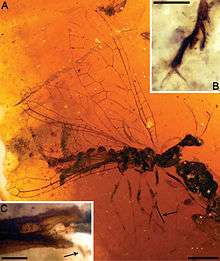






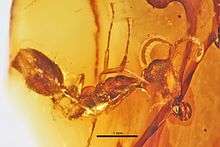
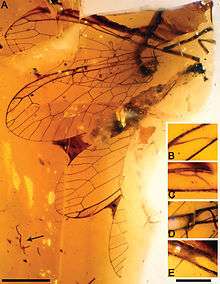
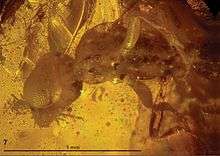


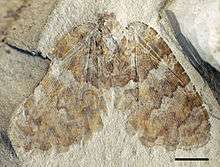


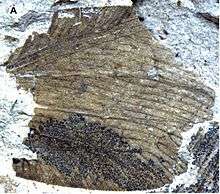









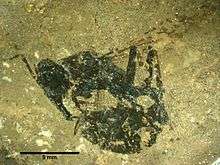


.jpg)




.png)




















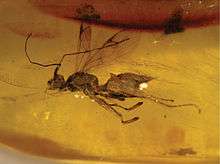

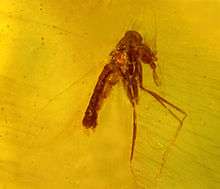



.jpg)